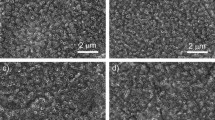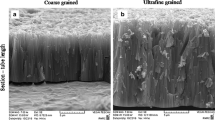Abstract
TiO2 nanotubes (NTs) have a great potential in improving the osetointegration of titanium (Ti)-based biomaterials. Much efforts have been made to evaluate the biological performance of the TiO2 nanotube in regulating protein adsorption and cells attachments. As often used in orthopaedic applications, although biotribological performance and biocorrosion are important issues in these applications, few researches have been reported on the biotribological performance of NT layers. This paper reports the preparation of a structure-optimised TiO2 NT (SO-NT) material via a multi-step oxidation strategy, as well as its biotribological and biocorrosion behaviours. In this procedure, an interfacial bonding layer of approximately 120 nm - 150 nm was first formed on the titanium substrate, which was then joined to the NT bottoms. The mechanical testing with respect to impact, bending, and biotribological performance have demonstrated the resultant SO-NT layer possess improved mechanical stability compared to conventional NT. The uniform hyperfine interfacial bonding layer with nano-sized grains exhibited a strong bonding to NT layer and Ti substrate. It was observed that the layer not only effectively dissipates external impacts and shear stress but also acts as a good corrosion resistance barrier to prevent the Ti substrate from corrosion. Theoretical models were proposed to analyze and predict the shear performance and corrosion-resistance mechanisms of the resultant material. The obtained results demonstrated that the SO-NT material has great potential in orthopaedic applications.
Similar content being viewed by others
References
Lee K, Mazare A, Schmuki P. One-dimensional titanium dioxide nanomaterials: Nanotubes. Chemical Reviews, 2014, 114, 9385–9454.
Macak J M, Tsuchiya H, Taveira L, Aldabergerova S, Schmuki P. Smooth anodic TiO2 nanotubes. Angewandte Chemie International Edition, 2005, 44, 7463–7465.
Brammer K S, Frandsen C J, Jin S. TiO2 nanotubes for bone regeneration. Trends Biotechnology, 2012, 30, 315–322.
Wang F, Shi L, He W X, Han D, Yan Y, Niu Z Y, Shi S G. Bioinspired micro/nano fabrication on dental implant-bone interface. Applied Surface Science, 2013, 265, 480–488.
Rho J Y, Kuhn-Spearing L, Zioupos P. Mechanical properties and the hierarchical structure of bone. Medical Engineering & Physics, 1998, 20, 92–102.
Zhang L J, Webster T J. Nanotechnology and nanomaterials: Promises for improved tissue regeneration. Nano Today, 2009, 4, 66–80.
Mendonca G, Mendonca D B S, Aragao F J L, Cooper L F. Advancing dental implant surface technology-From micron-to nanotopography. Biomaterials, 2008, 29, 3822–3835.
Li Y, Lee I S, Cui F Z, Choi S H. The biocompatibility of nanostructured calcium phosphate coated on micro-arc oxidized titanium. Biomaterials, 2008, 29, 2025–2032.
Palin E, Liu H, Webster T J. Mimicking the nanofeatures of bone increases bone-forming cell adhesion and proliferation. Nanotechnology, 2005, 16, 1828–1835.
Wang N, Li H Y, Lu W L, Li J H, Wang J S, Zhang Z T, Liu Y R. Effects of TiO2 nanotubes with different diameters on gene expression and osseointegration of implants in minipigs. Biomaterials, 2011, 32, 6900–6911.
Kwon D H, Lee S J, Wikesjo U M E, Johansson P H, Jo hansson C B, Sul Y T. Bone tissue response following local drug delivery of bisphosphonate through titanium oxide nanotube implants in a rabbit model. Journal of Clinical Periodontology, 2017, 9, 941–949.
Shen X K, Ma P P, Hu Y, Xu G Q, Xu K, Chen W Z, Ran Q C, Dai L L, Yu Y L, Mu C Y, Cai K Y. Alendronate-loaded hydroxyapatite-TiO2 nanotubesforimprovedboneformation in osteoporoticrabbits. Journal of Materials Chemistry B, 2016, 8, 1423–1436.
Salou L, Hoornaert A, Louarn G, Layrolle P. Enhanced osseointegration of titanium implants with nanostructured surfaces: An experimental study in rabbits. Acta Biomaterialia, 2015, 11, 494–502.
Yi Y A, Park Y B, Choi H, Lee K W, Kim S J, Kim K M, Oh S, Shim J S. The evaluation of osseointegration of dental implant surface with different size of TiO2 nanotube in rats. Journal of Nanomaterials, 2015, 2, 581713.
von Wilmowsky C, Bauer S, Lutz R, Meisel M, Neukam F W, Toyoshima T, Schmuki P, Nkenke E, Schlegel K A. In vivo evaluation of anodic TiO2 nanotubes: An experimental study in the pig. Journal of Biomedical Materials Research Part B: Applied Biomaterials, 2009, 89B, 165–171.
Geetha M, Singh A K, Asokamani R, Gogia A K. Ti based biomaterials, the ultimate choice for orthopaedic implants - A review. Progress in Materials Science, 2009, 54, 397–425.
Raphel J, Holodniy M, Goodman S B, Heilshorn S C. Multifunctional coatings to simultaneously promote osseointe-gration and prevent infection of orthopaedic implants. Biomaterials, 2016, 84, 301–314.
Cvijović-Alagić I, Cvijović Z, Mitrović S, Panić V, Rakin M. Wear and corrosion behavior of Ti-13Nb-13Zr and Ti-6Al-4V alloys in simulated physiological solution. Corrosion Science, 2011, 53, 796–808.
Hacisalihoglu I, Samancioglu A, Yildiz F, Purcek G, Alsaran A. Tribocorrosion properties of different type titanium alloys in simulated body fluid. Wear, 2015, 332–333, 679–686.
Ma M, Kazemzadeh-Narbat M, Hui Y, Lu S, Ding C, Chen D D, Hancock R E, Wang R. Local delivery of antimicrobial peptides using self-organized TiO2 nanotube arrays for peri-implant infections. Journal of Biomedical Materials Research Part A, 2012, 100, 278–285.
Oh S, Brammer K S, Julie L. Y S, Teng D, Engler A J, Chien S, Jin S. Stem cell fate dictated solely by altered nanotube dimensions. Proceedings of the National Academy of Sciences of the United States of America, 2009, 106, 2130–2135.
Qiao H X, Xiao H Y, Huang Y, Yuan C F, Zhang X J, Bu X P, Wang Z H, Han S G, Zhang L J, Su Z B, Zhang X J. SiO2 loading into polydopamine-functionalized TiO2 nanotubes for biomedical applications. Surface and Coatings Technology, 2019, 364, 170–179.
Huang Y, Shen X, Qiao H X, Yang H, Zhang X J, Liu Y Y, Yang H J. Biofunctional Sr- and Si-loaded titania nanotube coating of Ti surfaces by anodization-hydrothermal process. International Journal of Nanomedicine, 2018, 13, 633–640.
Xiong J Y, Wang X J, Li Y C, Hodgson P D. Interfacial chemistry and adhesion between titanium dioxide nanotube layers and titanium substrates. The Journal of Physical Chemistry C, 2011, 115, 4768–4772.
Ouyang H M, Fei G T, Zhang Y, Su H, Jin Z, Xu S H, Zhang L D. Large scale free-standing open-ended TiO2 nanotube arrays: Stress-induced self-detachment and in situ pore opening. Journal of Materials Chemistry C, 2013, 1, 7498–7506.
Wang D A, Hu T C, Hu L T, Yu B, Xia Y Q, Zhou F, Liu W M. Microstructured arrays of TiO2 nanotubes for improved photo-electrocatalysis and mechanical stability. Advanced Functional Materials, 2009, 19, 1930–1938.
Yu D L, Zhu X F, Xu Z, Zhong X M, Gui Q F, Song Y, Zhang S Y, Chen X Y, Li D D. Facile method to enhance the adhesion of TiO2 nanotube arrays to Ti substrate. ACS Applied Materials & Interfaces, 2014, 6, 8001–8005.
Macak J M, Albu S P, Schmuki P. Towards ideal hexagonal self-ordering of TiO2 nanotubes. Physica Status Solidi (RRL) - Rapid Research Letters, 2007, 1, 181–183.
Alves S A, Rossi A L, Ribeiro A R, Toptan F, Pinto A M, Celis J P, Shokuhfar T, Rocha L A. Tribo-electrochemical behavior of bio-functionalized TiO2 nanotubes in artificial saliva: Understanding of degradation mechanisms. Wear, 2017, 384–385, 28–42.
Park J W, Kim Y J, Jang J H, Kwon T G, Bae Y C, Suh J Y. Effects of phosphoric acid treatment of titanium surfaces on surface properties, osteoblast response and removal of torque forces. Acta Biomaterialia, 2010, 6, 1661–1670.
Cooper L F, Zhou Y S, Takebe J, Guo J L, Abron A, Holmen A, Ellingsen J E. Fluoride modification effects on osteoblast behavior and bone formation at TiO2 grit-blasted c.p. titanium endosseous implants. Biomaterials, 2006, 27, 926–936.
Aaseth J, Shimshi M, Gabrilove J L, Birketvedt G S. Fluoride: A toxic or therapeutic agent in the treatment of osteoporosis? The Journal of Trace Elements in Experimental Medicine, 2004, 17, 83–92.
Le Guehennec L, Soueidan A, Layrolle P, Amouriq Y. Surface treatments of titanium dental implants for rapid osseointegration. Dental Materials, 2007, 23, 844–854.
Sampaio M, Buciumeanu M, Henriques B, Silva F S, Souza J C M, Gomes J R. Tribocorrosion behavior of veneering biomedical PEEK to Ti6Al4V structures. Journal of the Mechanical Behavior of Biomedical Materials, 2016, 54, 123–130.
Acknowledgment
This project is financially supported by the EU via the H2020-MSCA-RISE-2016 program (Grant no: 734156), Royal Society via the International Exchange Program (Grant no: IE161349), Key Research Project from the National Key Research and Development Program of China (2016YFC1100401), National Natural Science Foundation of China (51705507), and Young Elite Scientists Sponsorship Program by CAST (2017QNRC001).
Author information
Authors and Affiliations
Corresponding authors
Supplementary material
Supplementary material, approximately 3.03 MB.
Supplementary material, approximately 3.55 MB.
Rights and permissions
About this article
Cite this article
Luo, J., Li, B., Ajami, S. et al. Growth of TiO2 Nanotube on Titanium Substrate to Enhance its Biotribological Performance and Biocorrosion Resistance. J Bionic Eng 16, 1039–1051 (2019). https://doi.org/10.1007/s42235-019-0116-2
Published:
Issue Date:
DOI: https://doi.org/10.1007/s42235-019-0116-2




